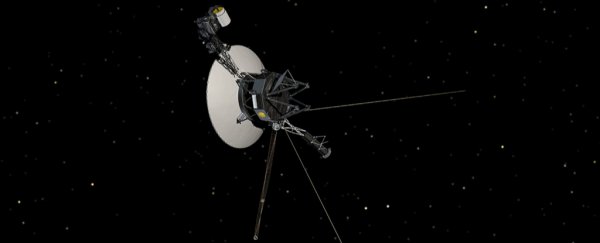When it comes to prodding the very boundaries of the Solar System we all reside in, astronomers have had a notoriously tricky time of figuring out where those edges truly lie.
For example, it took a whole year to officially confirm that Voyager 1 had reached the interstellar medium of space – the first spacecraft to ever do so.
But we might be about to get a confirmation of its cousin busting through the heliopause and into the interstellar medium as well; right now, we're only at rumour level, but one promising clue is this tweet by freelance science journalist Jonathan O'Callaghan:
I think it's happened, people. Voyager 2 appears to have left the Solar System, becoming the second interstellar spacecraft after Voyager 1 in August 2012. Expecting some sort of announcement from NASA tomorrow. pic.twitter.com/KnxcdZRX2y
— Jonathan O’Callaghan (@Astro_Jonny) December 9, 2018
It's important to note that there's a number of ways you can measure the end of the Solar System. For starters, it might make sense to say that the Solar System extends to the edge of the influence of the Sun.
That can mean several things, though: the end of the influence of the Sun's light (which doesn't really work when you think how far starlight can reach); or the edge of the Sun's magnetic field and solar wind (what Voyager 2 is on the brink of); or alternatively the influence of the Sun's gravity (which could push out the edge much farther than the Voyager probes, if the speculative Planet Nine is confirmed).
Technically, there is still Solar System material outside the heliosphere - the 'bubble' created by the Sun's solar winds. That material is the Oort Cloud, but it's generally accepted that it already resides in interstellar space.
So, reaching the interstellar medium is an impressive feat either way - it means both Voyagers would finally be flying through the void between the stars, where the Sun's solar winds are no longer able to reach them.
We're looking at a lot of speculation at this point, but here's one thing we know for sure - NASA has a press briefing this morning, coming up at the American Geophysical Union's 2018 meeting in Washington.
They might not call it just yet, as Voyager 1 entered the interstellar medium at around 121 AU (or 121 times the distance between the Sun and Earth), but Voyager 2 is currently at only 119 AU.
But we shouldn't have to wait a whole year, like we did with Voyager 1, as we have that original data to go on to confirm when Voyager 2 is no longer feeling the Sun's winds on its back.
The briefing will begin this morning, Monday 10 December, at 11 am EST (16:00 UTC), and you'll be able to watch it at the live stream below.
Editor's note (11 Dec 2018): An earlier version of this story lacked clarification on the difference between the hypothetical edge of the Solar System and the edge of the heliosphere. We have now amended the article to clearly indicate that difference.
